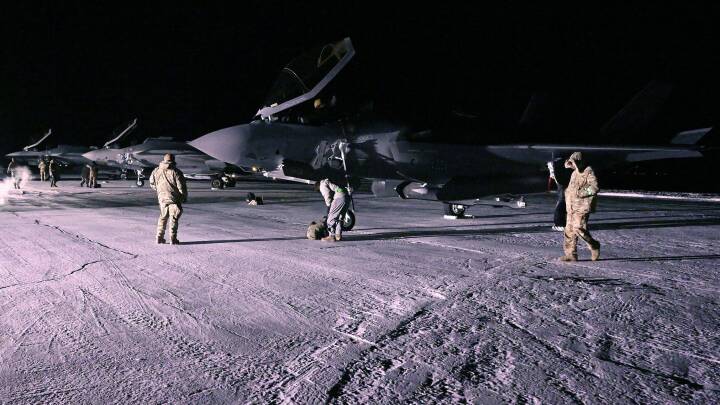
Significant, yet also predictable, that American F-35 fighter jets have been taking to the skies around Thule Air Base, say experts.
F-35 fighter jets have for the first time ever engaged in training exercises at the American airbase in Thule, North Greenland.
This happened in connection with joint American-Canadian exercises in the Arctic, which have just concluded.
“Our ability to operate in the Arctic is critical to our ability to defend our homelands,” said General Glen VanHerck, Commander, North American Aerospace Defense Command (NORAD) and U.S. Northern Command.
The exercises took place under the command of NORAD, the joint American-Canadian defense organization.
The exercises took place from Jan. 15 to 31 and included several bases in the Arctic, including in Alaska, along with Thule Air Base.
In total, 225 personnel from the American and Canadian forces participated in the exercises, and according to NORAD, the exercises successfully demonstrated that they are prepared to defend the northernmost areas of the U.S. and Canada should it be necessary.
‘Significant’
The exercises send a clear signal that the U.S. wanted to demonstrate that its newest jets are combat-capable in the Arctic.
This is according to Jeppe Strandsbjerg, associate professor at the Royal Danish Defence College and Nasiffik-Centre for Foreign and Security Policy at the University of Greenland.
“It is significant this year that it is the first time that there are F-35 jets at Thule Air Base because it demonstrates that they can operate in the north and that it can be done well,” says Strandsbjerg. He adds that “the Americans have been a little slow in realizing that the Arctic is of interest. Now they’ve renewed the cooperation with NORAD, and I see it as a part of an ongoing upgrading of experience and training to become better at taking action in the Arctic.”
A Balanced Signal
In its latest risk assessment of the threats to Denmark, the Danish Defence Intelligence Service also took a closer look at developments in the Arctic.
The Service expects to see an increased military presence in the region.
Ulrik Pram Gad is a senior researcher at the Danish Institute for International Studies, and his focus includes foreign and security policy in the Arctic.
He says that it is to be expected that the U.S. and Canada will want to test the F-35 jets to see if they can stand up to the Arctic environment.
“They are in the process of a slow rearmament in the Arctic, where they want to demonstrate that they can do things, but preferably without making them so permanent that they seem threatening,” he says. They are sending a superpower signal to Russia to show that they are serious enough about being able to defend themselves that they are practicing it now.”
More Exercises in the Arctic
Senior researcher in military studies at The University of Copenhagen, Kristian Søby Kristensen, explains that we need to get used to the types of exercises like those just undertaken by NORAD. It shows how important the Thule Air Base and its early warning radar system are for the defense of North America.
“As the U.S. becomes more concerned about the Russians, particularly after the invasion of Ukraine, more energy will be used on training and preparing to defend the air base,” he says.
Kristensen explains that both the U.S. and Canada have increased the pace of their training exercises in North America.
“This exercise is part of a pattern that saw air defense training in Thule by the Americans and Canadians,” he says.

Leave a Reply
You must be logged in to post a comment.